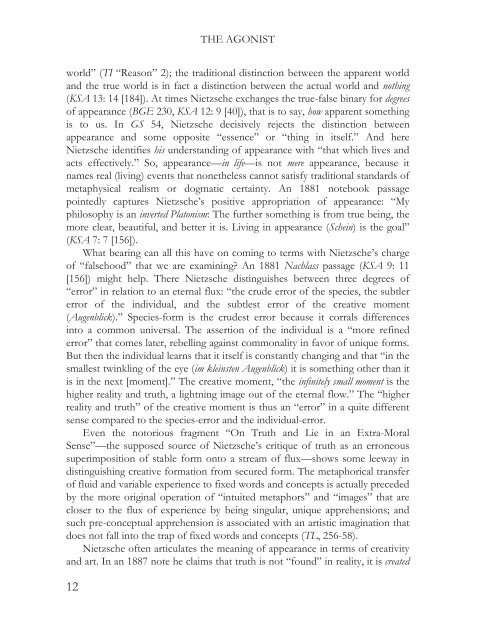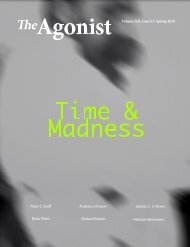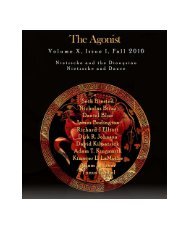Volume XI, Issue II, Spring 2018
Create successful ePaper yourself
Turn your PDF publications into a flip-book with our unique Google optimized e-Paper software.
THE AGONIST<br />
world” (TI “Reason” 2); the traditional distinction between the apparent world<br />
and the true world is in fact a distinction between the actual world and nothing<br />
(KSA 13: 14 [184]). At times Nietzsche exchanges the true-false binary for degrees<br />
of appearance (BGE 230, KSA 12: 9 [40]), that is to say, how apparent something<br />
is to us. In GS 54, Nietzsche decisively rejects the distinction between<br />
appearance and some opposite “essence” or “thing in itself.” And here<br />
Nietzsche identifies his understanding of appearance with “that which lives and<br />
acts effectively.” So, appearance—in life—is not mere appearance, because it<br />
names real (living) events that nonetheless cannot satisfy traditional standards of<br />
metaphysical realism or dogmatic certainty. An 1881 notebook passage<br />
pointedly captures Nietzsche’s positive appropriation of appearance: “My<br />
philosophy is an inverted Platonism: The further something is from true being, the<br />
more clear, beautiful, and better it is. Living in appearance (Schein) is the goal”<br />
(KSA 7: 7 [156]).<br />
What bearing can all this have on coming to terms with Nietzsche’s charge<br />
of “falsehood” that we are examining? An 1881 Nachlass passage (KSA 9: 11<br />
[156]) might help. There Nietzsche distinguishes between three degrees of<br />
“error” in relation to an eternal flux: “the crude error of the species, the subtler<br />
error of the individual, and the subtlest error of the creative moment<br />
(Augenblick).” Species-form is the crudest error because it corrals differences<br />
into a common universal. The assertion of the individual is a “more refined<br />
error” that comes later, rebelling against commonality in favor of unique forms.<br />
But then the individual learns that it itself is constantly changing and that “in the<br />
smallest twinkling of the eye (im kleinsten Augenblick) it is something other than it<br />
is in the next [moment].” The creative moment, “the infinitely small moment is the<br />
higher reality and truth, a lightning image out of the eternal flow.” The “higher<br />
reality and truth” of the creative moment is thus an “error” in a quite different<br />
sense compared to the species-error and the individual-error.<br />
Even the notorious fragment “On Truth and Lie in an Extra-Moral<br />
Sense”—the supposed source of Nietzsche’s critique of truth as an erroneous<br />
superimposition of stable form onto a stream of flux—shows some leeway in<br />
distinguishing creative formation from secured form. The metaphorical transfer<br />
of fluid and variable experience to fixed words and concepts is actually preceded<br />
by the more original operation of “intuited metaphors” and “images” that are<br />
closer to the flux of experience by being singular, unique apprehensions; and<br />
such pre-conceptual apprehension is associated with an artistic imagination that<br />
does not fall into the trap of fixed words and concepts (TL, 256-58).<br />
Nietzsche often articulates the meaning of appearance in terms of creativity<br />
and art. In an 1887 note he claims that truth is not “found” in reality, it is created<br />
12









